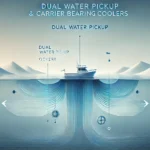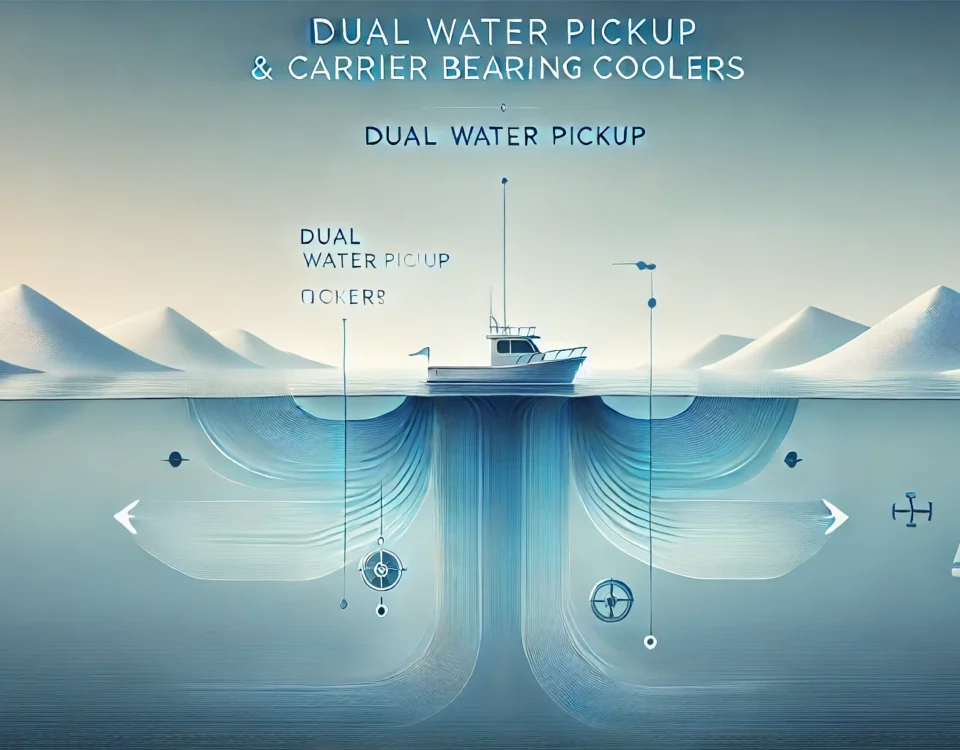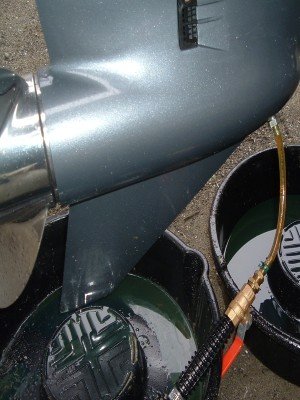
Everything You Need to Know About Dual Water Pickups Counter Rotation vs Standard Rotation and Carrier Bearing Coolers
August 6, 2025
How to Identify the Correct Yamaha Lower Unit with a Real-World Example
August 27, 2025Salt-Water-Rated Lower Units: The Complete Buyer’s & Care Guide (for Coastal, Brackish, and Offshore Boaters)
Why this guide?
If you run in the Gulf, Atlantic, Pacific, Arabian Sea, or any salty backwater in between, your lower unit (gearcase) is living in the harshest environment on your boat. This long-form guide explains what “salt-water-rated” should mean, how to tell if a gearcase is truly built for the ocean, and how to maintain it so it lasts. It’s written for boaters comparing OEM and aftermarket replacements and for shoppers considering the lower units you see on this website.
What “salt-water-rated” really means for a lower unit
“Salt-water-rated” is not a legal certification. Practically, it means the gearcase was designed, coated, and supported for saltwater corrosion resistance and maintenance:
- Marine-grade cast aluminum with low-copper content (commonly A356 or similar Al-Si alloys) resists pitting better than generic castings.
- Layered coatings that seal aluminum (metal prep/anodize or conversion coat), then primer, then topcoat—OEMs use multi-step systems specifically to fight salt spray and immersion.
- Service guidance that assumes saltwater—for example, manufacturers recommending fresh-water flushing after every salt trip.
- Warranty terms that don’t exclude saltwater and, in some cases, broad coverage on replacement gearcases offered by certain aftermarket vendors.
Bottom line: a true salt-water-ready lower unit combines corrosion-resistant alloys, a proven coating stack, clear maintenance directions for salt use, and a warranty that doesn’t carve out “no saltwater.”
Anodes 101: Zinc vs Aluminum vs Magnesium (and when to use which)
Your anodes are your first line of defense. Choosing the wrong metal is one of the fastest ways to ruin a gearcase.
| Water Type | Recommended Anode Metal | Why it matters |
|---|---|---|
| Saltwater | Zinc (traditional) or Aluminum (modern alternative) | Zinc has long been the saltwater standard; aluminum also performs well and is increasingly used. |
| Brackish | Aluminum | Zinc can under-protect in brackish; aluminum tends to cover the mixed conductivity range better. |
| Freshwater | Magnesium | It’s the most active and protects aluminum castings well in low-conductivity freshwater (never use Mg in salt). |
Quick tips
- Match your anode type to where you keep the boat moored, not where you occasionally run.
- Inspect anodes monthly in salt; replace when ~50% consumed.
- Keep paint off the anodes. Painted anodes don’t work.
Coatings & materials: What to look for (OEM vs aftermarket)
Alloy: Look for low-copper aluminum-silicon castings similar to A356 for the housing.
Coating stack:
- OEMs publish multi-stage processes (metal prep/conversion, primer, powder or liquid topcoats) built to resist salt fog and immersion. That layered system is a proven benchmark you can use when evaluating any replacement lower unit.
- Powder coatings can be very durable, but like any finish, chips must be touched up promptly. Ignored chips can creep under the coating in salt.
Takeaway for shoppers: When comparing the lower units you see on this website, look for language about aluminum-silicon alloys, epoxy/EDP primers, and marine-specific powder or paint systems (not just cosmetic paint).
Antifouling on aluminum gearcases: what’s safe (and what’s not)
If your gearcase lives in the water, growth will eventually stick—especially in warm saltwater. But copper-rich antifoulants can attack aluminum. Use aluminum-safe, copper-free products designed for outboards, sterndrive lowers, props, and tabs.
Safe directions:
- Choose aluminum-safe antifouling (e.g., cuprous thiocyanate or copper-free systems) made specifically for aluminum gearcases and underwater metals.
- Never apply cuprous-oxide bottom paint directly to aluminum outdrives/gearcases.
- Representative products: Interlux Trilux 33, TotalBoat Outdrive AF, and similar aluminum-safe lines. (Always follow the brand’s primer system.)
Saltwater maintenance checklist (simple routine that pays off)
After every salt or brackish run
- Fresh-water flush (5–10 minutes). Many engines allow flushing with the engine off via a dedicated port. Follow your make/model procedure.
- Rinse the gearcase to remove salt crystals before they start corrosion.
- If moored, tilt the gearcase out of the water to reduce galvanic activity and marine growth (except in freezing conditions).
Monthly (or every 25–50 hours)
- Inspect anodes; replace at ~50% depletion.
- Touch up nicks and chips in the coating. Bare aluminum + salt = rapid pitting.
- Check water pump tell-tale and intake screens for salt/grit blockage; flush again if the stream is weak.
Seasonal
- Change gear lube, inspect for water intrusion (milky oil).
- If stored in-water, consider an aluminum-safe antifouling on the gearcase and prop.
- Inspect bonding/ground wires and stainless fasteners for crevice corrosion.
Warranty realities for replacement gearcases
When you shop replacement lowers, you’ll see different warranty philosophies:
- OEM limited warranties typically cover defects in materials/workmanship for a set term; corrosion is often addressed separately and routine maintenance (flushing/anodes) is expected.
- Several aftermarket suppliers publicly advertise multi-year “no-fault” or “fault-free” warranties on assembled lower units (outboard and sterndrive). These describe coverage for failures requiring repair or replacement—even from impacts or fishing-line ingestion—and do not exclude saltwater use. Always read the full policy for shipping and exclusions.
Note from real-world users: Owner forums contain both positive experiences and complaints (e.g., paint bubbling when chips aren’t repaired). That’s less about “saltwater rated” on paper and more about how well the finish is maintained in the field.
Setup tips for harsh salt marinas (stop galvanic “mystery” damage)
- Confirm shore-power ground issues: Stray current in marinas accelerates corrosion. Use a galvanic isolator or transformer if applicable.
- Match anodes to neighbors: If your slip mates use different metals and you share ground, ask a pro to review your bonding system.
- Paint + anodes together: A fully sealed case + healthy anodes is the combo. A beautifully painted case with buried, over-painted anodes is unprotected.
- Rinse + dry: Salt crusts draw moisture. Rinse the case and let it drain vertically after use.
How to evaluate the lower units you see on this website (saltwater checklist)
Materials & Coatings
- Housing cast from marine aluminum (often A356-type alloy) or equivalent corrosion-resistant composition.
- Multi-stage finishing (conversion/anodize → primer → topcoat).
- Aluminum-safe antifouling available as an add-on if you store in water.
Hardware & Serviceability
- Stainless or protected fasteners with sealants on dissimilar-metal interfaces.
- Easy access to flush port and water intakes; owner’s manual guidance for post-salt flush.
Warranty & Support
- Coverage that does not exclude saltwater; ideally, clearly stated repair/replace terms for lower units. Some aftermarket options publicly advertise multi-year “fault-free” coverage.
Troubleshooting common saltwater complaints
“My paint is bubbling near edges and fasteners.”
Likely under-film corrosion creeping from a chip or from a dissimilar-metal contact point. Sand, prime, and topcoat. Keep stainless/Al interfaces sealed and isolated.
“Anodes aren’t wasting—but my case is.”
The anodes may be painted, fouled, or wrong metal for your water. Switch to aluminum anodes for brackish, verify electrical continuity, and scrape any growth off the anodes.
“Heavy growth in a couple of weeks.”
If you’re wet-slipped in warm saltwater, use an aluminum-safe, copper-free antifoulant on the gearcase/prop and keep up with touch-ups.
“Do I really need to flush every trip?”
Yes—every salt trip. A fresh-water flush after salt or brackish use is the cheapest life-extension you can do.
FAQs (People Also Ask)
Q: Are aftermarket lower units okay for saltwater?
A: Many are engineered for saltwater and backed by multi-year coverage. Look for corrosion-resistant alloys, a layered primer/topcoat system, and warranty terms that don’t exclude saltwater.
Q: Zinc or aluminum anodes for salt?
A: Zinc is traditional in salt; aluminum is also highly effective and a better all-rounder if you move between salt and brackish.
Q: Can I use copper bottom paint on an aluminum gearcase?
A: No. Use aluminum-safe (copper-free or cuprous-thiocyanate) antifouling designed for outboards/sterndrives.
Q: How often should I flush?
A: After every salt or brackish trip, and as soon as possible after hauling out.
Q: What about long-term mooring in salt?
A: Tilt the gearcase out when safe (not in freezing conditions), keep anodes fresh, and consider aluminum-safe antifouling on the case/prop.
Honest expectations in harsh salt
Even a perfectly “salt-water-rated” gearcase will corrode if chipped to bare metal, left with the wrong anodes, or never flushed. OEMs invest in multi-layer coatings and publish salt-use instructions for a reason. Aftermarket suppliers vary—some match those practices and even offer aggressive no-fault warranty coverage; others cut corners. Check the details and keep up with the simple care that salt demands.
Ready to compare options?
Browse the lower units you see on this website with the checklist above in mind. If you boat primarily in salt or brackish water, look for:
- corrosion-resistant alloy castings,
- an epoxy-style primer under a marine topcoat,
- aluminum-safe antifouling compatibility if you wet-slip, and
- warranty language that doesn’t shy away from saltwater use.
Have questions about anodes, paint systems, or flushing on your exact engine model? Tell us and we’ll try help you with this.




